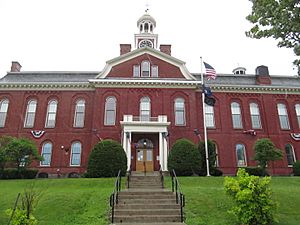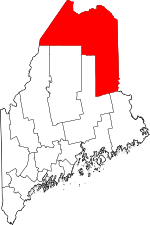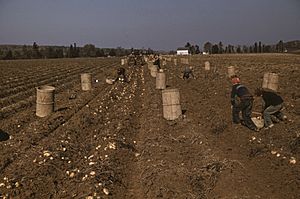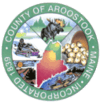Aroostook County, Maine facts for kids
Quick facts for kids
Aroostook County
|
|||
|---|---|---|---|

Aroostook County Courthouse
|
|||
|
|||

Location within the U.S. state of Maine
|
|||
 Maine's location within the U.S. |
|||
| Country | |||
| State | |||
| Founded | May 1, 1839 | ||
| Named for | Miꞌkmaq word meaning "beautiful water" | ||
| Seat | Houlton | ||
| Largest city | Presque Isle | ||
| Area | |||
| • Total | 6,828 sq mi (17,680 km2) | ||
| • Land | 6,671 sq mi (17,280 km2) | ||
| • Water | 156 sq mi (400 km2) 2.3% | ||
| Population
(2020)
|
|||
| • Total | 67,105 | ||
| • Density | 9.8279/sq mi (3.79458/km2) | ||
| Time zone | UTC−5 (Eastern) | ||
| • Summer (DST) | UTC−4 (EDT) | ||
| Congressional district | 2nd | ||
Aroostook County (/əˈruːstək, -ˈrʊs-/ Ə-rooss-TƏK-,_--RUUSS--; French: Comté d'Aroostook) is a county in the U.S. state of Maine along the Canada–United States border. As of the 2020 census, the population was 67,105. The county seat is Houlton, with offices in Caribou and Fort Kent.
Known in Maine as "The County", it is the largest county in Maine by total area, the second-largest in the United States east of the Mississippi River by total area (behind St. Louis County, Minnesota), and the 31st-largest county in the entire contiguous U.S. With over 6,800 square miles (18,000 km2) of land; it is larger than three of the smaller U.S. states. It is Maine's northernmost county; the state's northernmost village, Estcourt Station, is also the northernmost community in the New England region and in the contiguous United States east of the Great Lakes.
Aroostook County is known for its potato cultivation, and it is an emerging hub for wind power. Historically, Acadian culture and heritage is well-represented in the county. In the Saint John Valley (northern Aroostook county), which borders Madawaska County, New Brunswick, many of the residents are bilingual in English and Acadian French. Elsewhere in Maine, New England French is the predominant form of French spoken. As well, the original inhabitants of the area, the Wolastoqiyik still remain in their country (Wolastokuk) as the Houlton Band of Metaksonekiyak Wolastoqewiyik.
Aroostook County forms the entirety of the Presque Isle media market, according to Nielsen Media Research.
Contents
Etymology
The name Aroostook comes from the Wolastokwey (or Maliseet) word Woolahstook, referring to the Saint John River or "Wolastoq", which means "beautiful river".
History
Named for the Wolastoq River, Aroostook's bounds fall completely within Maliseet Country, natively called Wolastokuk. Confederated with neighboring nations like the Mi'kmaq and Abenaki, the Wolastoqiyik (or Maliseet) Nation and their country comprised and still comprises one part of the Wabanaki Confederacy. This confederation covering several countries across Dawnland (what is now New England and the Canadian Maritimes) came together and confederated during the European and British colonization of the Americas.
The sparsely populated North Maine Woods, roughly defined as the headwaters of the Saint John, Penobscot and Kennebec Rivers, was populated during the colonial era by refugees fleeing oppressive governments. Native Americans, particularly Dawnlanders, (retreating from hostile European colonists, and smugglers trading with them, and between English Massachusetts and French Acadia) lived in small communities along the Atlantic coast on the disputed border between those colonies. As England dominated the Gulf of Maine following the French and Indian Wars, these occupants of the border region retreated up the large rivers into the interior, joined by Acadians escaping the Acadian Expulsion. Most Acadians and Wolastoqewiyik found refuge in Canada's Madawaska county, but several communities stayed in what would become the United States, including the Houlton Band of Maliseet Indians, also known as the Metaksonekiyak Wolastoqewiyik. Although the survivors might have preferred to remain independent, surrounding governments dividing their refuge, considering Aroostook County as the west bank of the Saint John River drainage basin upstream of Canada. Under United States control, the area was initially dominated by lumber manufacturing interests, although agriculture became important as population increased. Transportation along the Saint John River, and early rail connections into New Brunswick, created strong business ties with Canada, until the county was connected to the United States rail network by the Bangor and Aroostook Railroad in 1894. Aroostook County residents retain an independent cultural identity established during their history of isolation on the border frontier.
Aroostook County was formed, in 1839, from parts of Penobscot and Washington counties. Between 1843 and 1844, the county gained more land from Penobscot County, and further exchanged land with Piscataquis County. In 1889, Aroostook gained a small amount of Penobscot land, subsequently giving it back in 1903, when Aroostook County took on its current form. Some of the territory in the county was part of the land dispute that led to the "Aroostook War", a dispute which would be settled by the Webster–Ashburton Treaty.

The county was also part of a route on the Underground Railroad, and was one of the last stops before entering Canada. Slaves would meet and hide just outside Aroostook or in deserted areas. Friends Quaker Church near Fort Fairfield was often a final stop.
Much of Aroostook County's economy was dominated by military spending through the Cold War. Limestone Army Air Field was built in Limestone, Maine, in 1947. It was renamed Loring Air Force Base (AFB) in 1953 as the home of the Strategic Air Command (SAC) 42d Bombardment Wing operating Convair B-36 Peacemaker bombers. Aroostook County was chosen due to its strategic location as the closest point in the Continental United States to the Middle East and Europe including the Soviet Union west of the Ural Mountains. Loring AFB could accommodate one hundred of these large bombers; and had both the largest fuel storage capacity, at 9,200,000 US gallons (35,000,000 L), and the largest weapons storage capacity, at 4700 tonnes NEW, of any SAC base. The 42d Bombardment Wing at Loring operated Boeing B-52 Stratofortress bombers until the 1991 Base Realignment and Closure Commission recommended closure and the base closed in 1994.
The 2014 Acadian World Congress was held along the Canada–United States border, co-hosted by Aroostook County and a number of neighboring counties in Canada (Témiscouata in Quebec, and Victoria, Madawaska and Restigouche in New Brunswick). Organizers planned a Tintamarre that was held in the town of Madawaska, Maine, as well as a giant tug of war across the Saint John River.
Geography
According to the U.S. Census Bureau, the county has a total area of 6,828 square miles (17,680 km2), of which 6,671 square miles (17,280 km2) is land and 156 square miles (400 km2) (2.3%) is water. Aroostook County is Maine's largest county by area, about the size of Connecticut and Rhode Island combined. The county high point is Peaked Mountain, elevation 2,230 feet (680 m), whose western slopes are in the north east corner of Piscataquis County.
Adjacent counties and municipalities
- Washington County – southeast
- Penobscot County – south
- Piscataquis County – south
- Somerset County – southwest
- Montmagny Regional County Municipality, Quebec – west
- L'Islet Regional County Municipality, Quebec – west
- Kamouraska Regional County Municipality, Quebec – northwest
- Témiscouata Regional County Municipality, Quebec – north
- Madawaska County, New Brunswick – northeast
- Victoria County, New Brunswick – east
- Carleton County, New Brunswick – east
- York County, New Brunswick – southeast
National protected area
Major highways
 I-95
I-95 US 1
US 1 US 1A
US 1A US 2
US 2 US 2A
US 2A SR 10
SR 10 SR 11
SR 11 SR 89
SR 89 SR 161
SR 161 SR 164
SR 164 SR 171
SR 171
Demographics
| Historical population | |||
|---|---|---|---|
| Census | Pop. | %± | |
| 1840 | 9,413 | — | |
| 1850 | 12,529 | 33.1% | |
| 1860 | 22,479 | 79.4% | |
| 1870 | 29,609 | 31.7% | |
| 1880 | 41,700 | 40.8% | |
| 1890 | 49,589 | 18.9% | |
| 1900 | 60,744 | 22.5% | |
| 1910 | 74,664 | 22.9% | |
| 1920 | 81,728 | 9.5% | |
| 1930 | 87,843 | 7.5% | |
| 1940 | 94,436 | 7.5% | |
| 1950 | 96,039 | 1.7% | |
| 1960 | 106,064 | 10.4% | |
| 1970 | 92,463 | −12.8% | |
| 1980 | 91,331 | −1.2% | |
| 1990 | 86,936 | −4.8% | |
| 2000 | 73,938 | −15.0% | |
| 2010 | 71,870 | −2.8% | |
| 2020 | 67,105 | −6.6% | |
| 2023 (est.) | 67,351 | −6.3% | |
| U.S. Decennial Census 1790–1960 1900–1990 1990–2000 2010–2016 |
|||
2010 census
As of the 2010 United States Census, there were 71,870 people, 30,961 households, and 19,578 families residing in the county. The population density was 10.8 inhabitants per square mile (4.2/km2). There were 39,529 housing units at an average density of 5.9 per square mile (2.3/km2). The racial makeup of the county was 95.7% white, 1.7% Native American, 0.6% black or African American, 0.4% Asian, 0.2% from other races, and 1.4% from two or more races. Those of Hispanic or Latino origin made up 0.9% of the population. In terms of ancestry, 27.2% were of French origin, 18.1% English, 17.4% Irish, 8.2% French Canadian (counted separately from French), 8.1% American, and 5.2% of German heritage.
In 2010, 18.0% of the population reported speaking French at home; other than speakers of English, there were no other significant linguistic groups.
Of the 30,961 households, 25.5% had children under the age of 18 living with them, 49.6% were married couples living together, 9.4% had a female householder with no husband present, 36.8% were non-families, and 30.8% of all households were made up of individuals. The average household size was 2.26 and the average family size was 2.79. The median age was 45.3 years.
The median income for a household in the county was $36,574 and the median income for a family was $47,114. Males had a median income of $37,222 versus $28,244 for females. The per capita income for the county was $20,251. About 10.6% of families and 15.4% of the population were below the poverty line, including 20.4% of those under age 18 and 11.7% of those age 65 or over.
Communities
Cities
Incorporated towns
- Allagash
- Amity
- Ashland
- Blaine
- Bridgewater
- Castle Hill
- Caswell
- Chapman
- Crystal
- Dyer Brook
- Eagle Lake
- Easton
- Fort Fairfield
- Fort Kent
- Frenchville
- Grand Isle
- Hamlin
- Hammond
- Haynesville
- Hersey
- Hodgdon
- Houlton
- Island Falls
- Limestone
- Linneus
- Littleton
- Ludlow
- Madawaska
- Mapleton
- Mars Hill
- Masardis
- Merrill
- Monticello
- New Canada
- New Limerick
- New Sweden
- Oakfield
- Orient
- Perham
- Portage Lake
- Saint Agatha
- Saint Francis
- Sherman
- Smyrna
- Stockholm
- Van Buren
- Wade
- Wallagrass
- Washburn
- Westfield
- Westmanland
- Weston
- Woodland
Plantations
Census-designated places
Unincorporated communities within towns
- California
- Clayton Lake
- Crouseville
- Daigle
- Estcourt Station
- Fort Kent Mills
- Portage
- Saint David
- Sinclair
- Smyrna Mills
- Wytopitlock
Unorganized territories
Indian reservations
- Aroostook Band of Mi'kmaq Indians Reservation, located in Presque Isle
- Houlton Band of Maliseet Indians Reservation, located in Houlton
See also
 In Spanish: Condado de Aroostook para niños
In Spanish: Condado de Aroostook para niños



